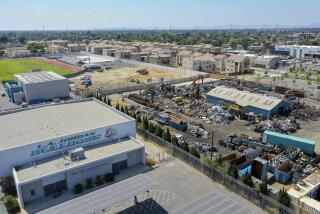Column: America’s first ‘21st century nuclear plant’ already has been shut down for repairs
- Share via
When the Tennessee Valley Authority’s Watts Bar 2 nuclear power plant was finally approaching completion the big public utility hailed it as “the nation’s first new nuclear generation of the 21st century.”
That was in October 2015, and the plant was thought to be only a few months away from going online. But it wasn’t until October 2016 that Watts Bar 2 began operating commercially. In March, just over five months later, the plant went offline — and it’s expected to remain offline at least into this summer, the TVA region’s peak period for electrical demand.
The 21st century is shaping up as not a good one for nuclear power, and Watts Bar Unit 2 may show why. The U.S. nuclear industry is running in neutral, except when it runs in reverse. Other than Watts Bar 2, the last new nuclear plant to enter American service is now nearly 20 years old — TVA’s 1996-vintage Watts Bar Unit 1.
California is on the verge of exiting the nuclear power field entirely, with the planned mothballing of Pacific Gas & Electric’s Diablo Canyon power plant. Diablo Canyon’s two reactors are to be shut down in 2024 and 2025 as part of a deal reached last year for the utility’s transition to other renewable sources. That deal followed the 2013 decision of Southern California Edison to permanently close San Onofre, the state’s only other nuclear power plant, following a botched attempt at its refurbishment.
Nuclear technology is very unforgiving.
— David Lochbaum, Union of Concerned Scientists
The immediate cause of the Watts Bar shutdown is the failure of components of the unit’s condenser, which cools steam used to drive the generating turbines back into water. TVA took the plant off-line on March 23 and is still trying to pinpoint the cause of the condenser failure.
But the problems at Watts Bar arise from more than just a structural failure of the condenser. They’re also connected to the plant’s long gestation and to maladies endemic to the entire nuclear power industry.
Watts Bar 2 holds the world record for the longest gestation of any nuclear plant in history, having been listed as “under construction” for 43 years. Construction was launched in 1972 and suspended in 1985, when the plant already was 60% complete. By then, despite an initial cost estimate of about $400 million, some $1.7 billion had been spent. Construction resumed in 2007. The total cost is now estimated at $6.1 billion.
Because of that time frame, Watts Bar 2 incorporated old technology, some of which is no longer considered acceptable in nuclear power plants today. The condenser itself was part of the original construction, though TVA says it was “completely refurbished” as part of the resumption of construction. They say upgrades and improvements, including safety provisions implemented following Japan’s 2011 Fukushima power plant disaster, have made Unit 2 “like new.”
But even polished-up nuclear power plants are harder to manage than conventional oil, gas or coal-fired plants. “Nuclear technology is very unforgiving,” says David Lochbaum, director of the nuclear safety project at the Union of Concerned Scientists. That’s true even of components other than the nuclear reactor itself.
A failing condenser at a fossil-fueled power plant, Lochbaum observes, could be kept online for months, with a fix deferred until a low-peal period after the summer. “With nuclear technology, you don’t really have that luxury.” Although the condenser system is technically separate from the reactor system, under certain circumstances it could be needed to dissipate into the environment heat produced when the plant’s nuclear reactor is running at full power. That makes it a more critical component than it would be in a fossil-fueled generating plant. (TVA says there’s no danger that the condenser failure could lead to the release of radioactivity into the environment.)
Such tight tolerances consistently have bedeviled nuclear plant operators. “The nuclear industry is very optimistic about its projections of performance,” Lochbaum says. “This is more evidence that they need to temper that optimism.”
Questions also persist about TVA’s management record and its implications for plant safety. The federal Nuclear Regulatory Commission in March 2016 labeled Watts Bar a “chilled work environment,” signifying that employees did not consider themselves free to raise safety concerns without fear of retaliation. Nevertheless, Watts Bar consistently has led all other nuclear plants in the nation in the number of allegations from plant personnel of safety or regulatory issues at the plant, with 33 recorded by the NRC in 2016. No other plant had more than 18 allegations — and that was the Sequoyah plant, also owned and operated by TVA.
The NRC hasn’t expressed the view that the environment had anything to do with the condenser failure and shutdown of the plant. But it ordered TVA to improve the safety culture at Watts Bar. But a consultant reported just three weeks ago that conditions haven’t improved measurably, citing “management behaviors that include harassment, intimidation, retaliation, and discrimination.” The report found that “mistrust permeates the [Watts Bar] organization,” and blamed TVA for failing to come to terms with an atmosphere that could “increase the risk of inhibiting individuals from reporting safety concerns that could well avoid safety events.”
Watts Bar, the so-called 21st century American nuclear plant, defines the crisis facing the U.S. nuclear industry. It’s stuck with outmoded technology and a management culture that exacerbates, rather than constrains, the technology’s safety issues. With every episode like this, the industry moves one step further away from making the case for its survival.
Keep up to date with Michael Hiltzik. Follow @hiltzikm on Twitter, see his Facebook page, or email [email protected].
Return to Michael Hiltzik’s blog.
More to Read
Sign up for Essential California
The most important California stories and recommendations in your inbox every morning.
You may occasionally receive promotional content from the Los Angeles Times.











